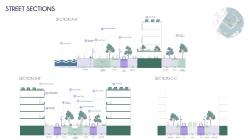"A HARBOUR CITY THAT IS HARMONIZED BY THE URBAN METABOLISM WITH THE FOCUS ON SELF-SUFFICIENCY ON A HUMAN-CENTRIC SCALE WITH CIRCULAR LIVING AND WORKING."
The Harbour Metabolism project envisions transforming Amsterdam’s Coen- and Vlothaven into a self-sustaining, human-centric harbour city grounded in principles of circularity and Industry 5.0. This forward-thinking concept emphasizes industrial symbiosis, urban metabolism, and circular living, integrating innovative technologies, policies, and community-driven strategies.
Our approach reimagines the harbour as a dynamic ecosystem, linking industry, public spaces, and communities through efficient resource use and sustainable urban practices. The project prioritizes adaptive reuse of existing infrastructure, modular building principles, and smart energy systems to achieve resilience and sustainability at all scales. Central to the design is a strong focus on human well-being, community engagement, and education, fostering an environment that harmonizes work, living, and ecological responsibility.
The proposal incorporates renewable energy sources, urban mining, and sustainable manufacturing, while creating green corridors, vibrant public spaces, and efficient transportation networks. By addressing circularity at multiple scales—from individual buildings to the Eurodelta region—the Harbour Metabolism project aims to establish a replicable model for future urban developments.
This project also explores the development of Scaled Solutions As Renewable Energy Production Within The Built-Up Environment, examined through four scales to achieve detailed implications and implementation possibilities. These scenarios are categorized based on their feasibility and scope:
1. Structure/Building: Human-scaled renewable energy solutions integrated into built environments, with an implementation feasibility of 0-49%.
2. Street: Streets designed to support renewable energy systems, achieving a feasibility of 50-74%.
3. District: Integration of multiple renewable energy sources connected through power grid systems, with a feasibility of 75-94%.
4. Eurodelta: Large-scale regional strategies to connect harbours and implement circular systems, achieving 95-100%.
Mission Statement
To create a harbour city harmonized by urban metabolism, focusing on self-sufficiency within a human-centric, circular framework that promotes innovation, inclusivity, and sustainability.
Vision
A continuously evolving system where human-centric values, advanced technologies, and sustainable practices drive circular development, enhancing the quality of life for all generations.
Key Strategies
Urban Mining: Utilizing existing structures and materials to minimize resource extraction and support sustainable construction. Warehouses and industrial buildings are repurposed to align with circularity principles.
Circular Community Programs: Developing community-focused initiatives that educate individuals on sustainable practices, such as urban farming, recycling, and shared resource management, fostering a culture of circularity.
Renewable Energy Integration: Establishing renewable energy hubs powered by solar, wind, and kinetic sources. These hubs are connected through smart grids to provide efficient, decentralized energy distribution across districts.
Efficient Transportation Systems: Enhancing public transit options while promoting pedestrian and cycling infrastructure. This reduces urban congestion and environmental impact while improving connectivity within and beyond the harbour area.
Green Infrastructure Development: Introducing urban forestry, green roofs, and water retention systems to combat urban heat islands, improve biodiversity, and support sustainable urban living.
Intergenerational Circularity: Bridging knowledge and practice gaps between generations to promote innovation and inclusive participation in sustainable projects. Workshops and knowledge-sharing platforms are established to support this exchange.
Policy Integration for Circularity: Aligning local, regional, and national governance frameworks with circularity objectives. Policies are designed to enforce resource efficiency, promote renewable energy adoption, and streamline cross-sector collaboration.
Technological Advancements in Urban Management: Deploying advanced technologies such as automated resource monitoring, smart grids, and data-driven planning tools to enhance infrastructure efficiency and sustainability.
Circular Consumption Models: Encouraging shared economies through initiatives such as community tool libraries, shared agricultural networks, and modular purchasing systems. These reduce overall consumption rates and foster collaboration.
2024
Core Components:
-Urban Metabolism Framework
Circularity principles: Reuse, recycle, remanufacture
Adaptive reuse of industrial buildings
Modular construction techniques
-Energy Systems
Renewable energy sources: Solar, wind, kinetic energy
Smart grids and decentralized energy distribution
-Green Infrastructure
Urban forestry, green roofs, vertical gardens
Integrated water retention systems
-Mobility and Accessibility
Expanded public transit networks
Dedicated bike and pedestrian pathways
-Community Engagement
Circular education programs
Community spaces for social and economic interaction
Designer Team:
Elif Ertemiz
Qian Chen
Elies Horemans
Yuhan Liu
Supervisors:
Prof. Dipl.-Ing. Christa Reicher
Dr. Fabio Bayro Kaiser
Harbour Metabolism by Elif Ertemiz in Netherlands won the WA Award Cycle 49. Please find below the WA Award poster for this project.

Downloaded 0 times.
Favorited 1 times


















